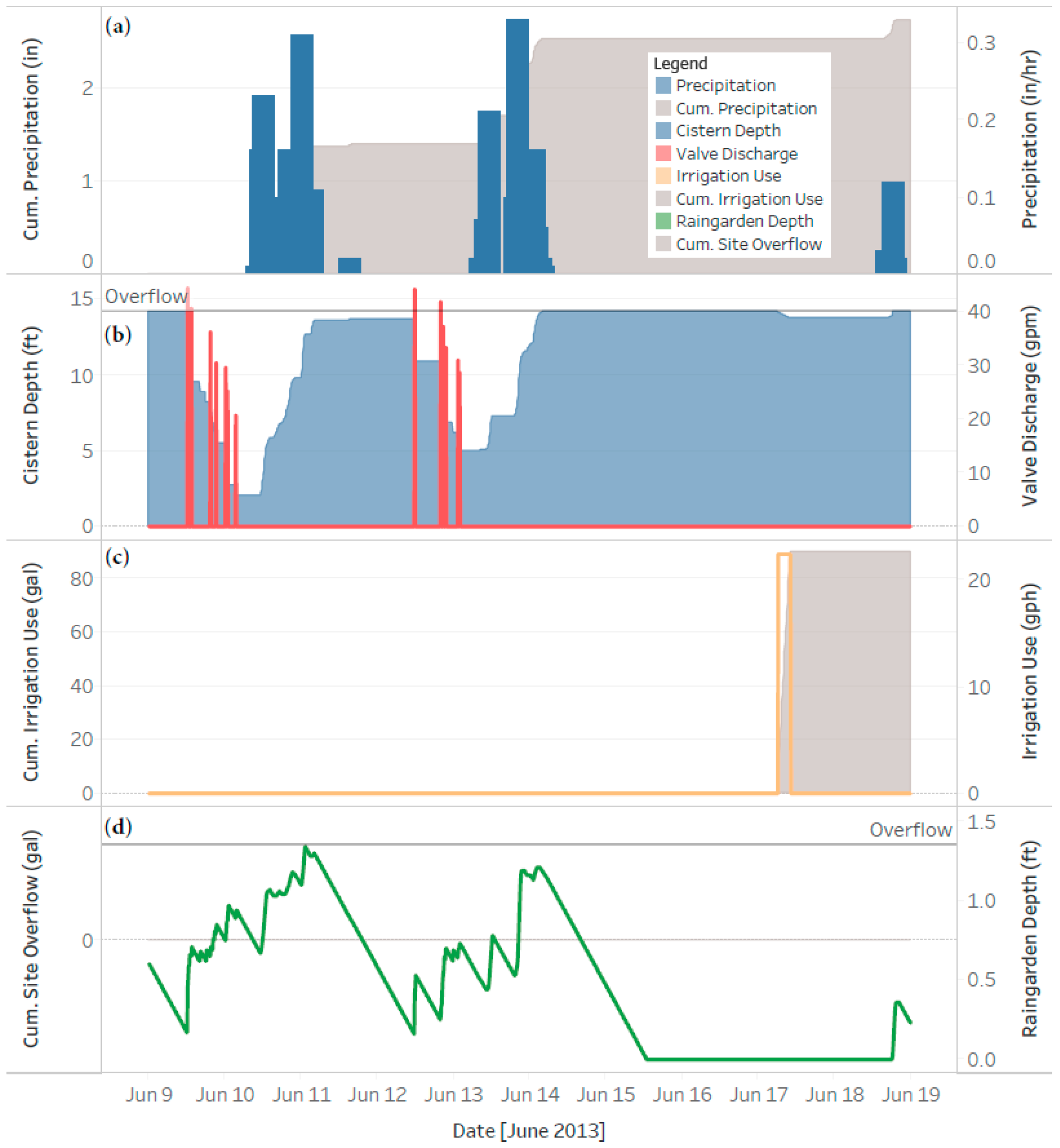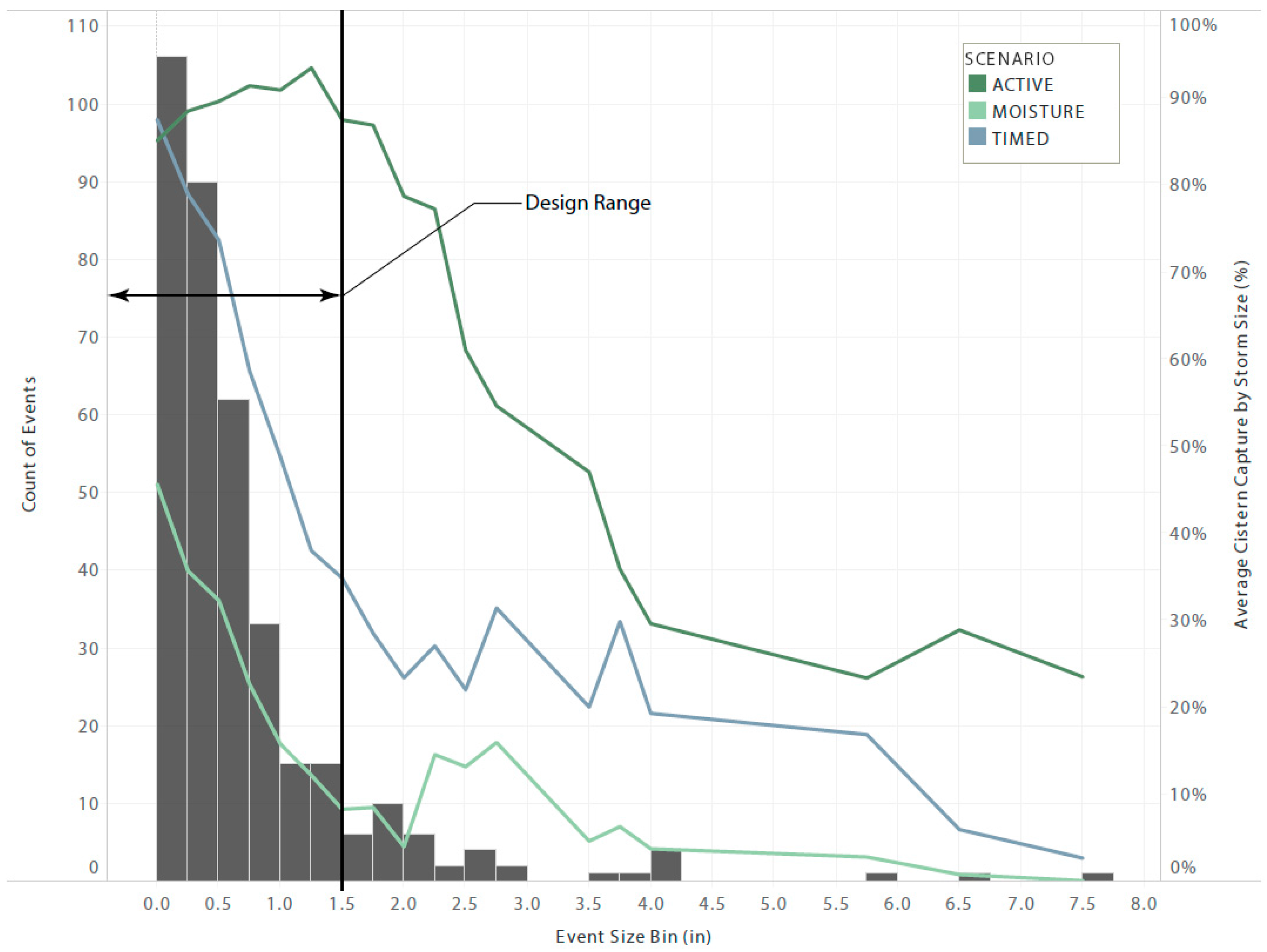1. Introduction
Discharge of wastewater, sewage, and stormwater runoff from coastal cities remains the dominant source of coastal zone pollution [
1]. The impervious nature of modern cities is exacerbating this problem by increasing runoff from city surfaces, triggering Combined Sewer Overflows (CSOs) and intensifying urban flooding. Management of urban stormwater to mitigate CSOs is a priority for many cities; however, few truly innovative approaches have been proposed to address this widespread problem. For example, conventional rainwater harvesting systems are widely used throughout urbanized areas in the United States for water conservation, but typically overflow during rainfall events and provide minimal reduction of runoff [
2].
Recent advances in information technology infrastructure, as well as hardware and software solutions, collectively known as the Internet of Things (IoT), are now providing cost-effective opportunities to achieve better performance of stormwater infrastructure. IoT is a network of physical objects embedded with electronics, software, sensors, and network connectivity, which enables these objects to collect and exchange data [
3]. In the context of stormwater management, IoT can be applied to provide Continuous Monitoring and Adaptive Control (CMAC) of traditionally static stormwater facilities [
4]. The CMAC approach aggregates information from on-site sensors (e.g., water level measurements) and weather forecasts, then implements custom logic based on these data sources to make automated decisions about when and how to store or release water collected from sites incorporating stormwater infrastructure. The intent of this approach is to optimize stormwater infrastructure to meet specific site objectives, including minimization of stormwater runoff, water conservation, and water quality enhancements.
An example application of CMAC would involve opening a valve to drain a cistern prior to forecast rainfall to create additional storage for incoming runoff and, therefore, minimize outflows during periods of active rainfall. Many types of infrastructure can be optimized by CMAC, including bioretention cells, cisterns, wet ponds, dry ponds, green roofs, and site connection tanks. Previous research has shown that a 59 m
3 CMAC system can potentially achieve the same reduction in wet weather flow (i.e., outflows during periods of active rainfall) as a 510 m
3 static system. Thus, the CMAC system from this previous research provides the same wet weather performance at 11.5% the size [
5].
Field testing of CMAC has demonstrated additional benefits beyond wet weather control. One of the original CMAC applications for water resources research was control of tide gates to enhance restoration of impounded salt marsh vegetation while simultaneously improving flood control protection [
6]. A controlled basin in Pflugerville, Texas, achieved a 6-fold reduction in nitrate plus nitrite-nitrogen compared to the same pre-retrofit dry basin (0.66–0.11 mg/L) by extending detention time and releasing water before a storm to create additional storage [
7]. Many other studies and field implementation sites demonstrating similar benefits for a variety of goals (e.g., flood control, wet-weather reduction, water quality) have been performed across the county [
4,
5,
8,
9].
An advanced rainwater harvesting system (ARHS) that will be operated using CMAC was designed at the St. Mary’s Recreation Center (“the site”), located in the Bronx River sewershed (BRS) of New York City. The ARHS was designed to collect (or harvest) rainwater from the roof of the recreation center and store the water in a cistern for on-site use, including irrigation use. Specifically, the harvested rainwater in the cistern was to be available for irrigation of a grassed area adjacent to a proposed raingarden. The raingarden was designed to collect runoff from an adjacent driveway area in addition to controlled discharge from the cistern. The combined design plans for the ARHS and raingarden were approved by the New York City Department of Buildings (New York, NY, USA) on 28 February 2017 [
10].
Figure 1 provides a schematic overview of the system’s design.
As shown in
Figure 1, the ARHS is primarily comprised of a cistern with a controlled discharge line, an irrigation pump, and monitoring sensors (e.g., water level, soil moisture, etc.). The ARHS was designed to be connected to a CMAC platform, powered by OptiRTC (Opti, Boston, MA, USA). Opti is a technology company that delivers a cloud-based platform for CMAC of distributed stormwater infrastructure. For the design illustrated in
Figure 1, the Opti system will be used to optimize operation of the system based on real-time data feeds from installed sensors and weather forecasts.
The primary objective of this study was to demonstrate that a CMAC approach can be applied to a conventional rainwater harvesting system in New York City to improve performance by minimizing discharge to the combined sewer during rainfall events, reducing water use for irrigation of local vegetation, and optimizing vegetation health. To achieve this objective, a hydrologic and hydraulic model was developed for the planned and designed rainwater harvesting system to explore multiple potential scenarios prior to the system’s actual construction. Specifically, a comparative analysis of model simulations was performed between the CMAC approach and two conventional rainwater harvesting approaches, including timer based and moisture based irrigation approaches.
4. Discussion
The primary objective of this study was to demonstrate that a CMAC approach can be applied to a conventional rainwater harvesting system in New York City to improve performance by minimizing discharge to the combined sewer during rainfall events, reducing water use for irrigation of local vegetation, and optimizing vegetation health.
Model results mirror previous studies [
4] and indicate that the CMAC rainwater harvesting system is expected to provide significant performance improvements over conventional rainwater harvesting systems. The CMAC system is expected to capture and retain 76.6% of roof runoff per year on average, as compared to just 14.8% and 41.3% for conventional moisture and timer based systems, respectively. When examining results on a per event basis, the CMAC system is simulated to capture 85% to 93% of all roof runoff to the cistern, on average, for rainfall events smaller than or equal to 3.8 cm during the period of record. Similarly, the CMAC system is expected to use 81.4% and 18.0% less harvested rainwater than conventional moisture and timer based irrigation systems, respectively. Indicator statistics such as water availability also suggest that the CMAC system will be effective at maintaining adequate volumetric water content with the root zone to keep irrigated grass healthy. The rainwater harvesting system is scheduled to be constructed in the summer of 2018. Once constructed, it is expected that components of the system will be continuously monitored, and a data analysis will be performed to validate modeling results presented herein.
Though promising, the results of this study also highlight the need for additional research to better understand the potential scale and costs of CMAC implementation required to produce a measurable change towards minimization of CSOs in urbanized areas such as New York City. For example, previous studies found that a CMAC retrofit of an existing stormwater detention facility would be approximately three times lower in cost than the equivalent passive alternative based on whole life cycle costs [
18], but the scalability of these savings is still unclear. Previous research has identified that one of the biggest foreseeable challenges to advancing the state of the CMAC practice will be to apply systems thinking to understanding the complex spatiotemporal dynamics that govern water flow and quality across large urban areas—i.e., benefits achieved at a local scale may be masked or eliminated at the city scale if the performance of an individual element is not designed in a broader systems context [
9]. Regional implementation of many distributed CMAC systems will require potentially complex and careful logic implementation to ensure that that unintended consequences are minimized. For example, releasing stored water from dozen(s) of regional CMAC systems at the same time prior to a forecasted storm rather than staggering releases could feasibly result in a pre-storm CSO.
It should also be mentioned that automated process control in water and wastewater treatment have been studied extensively; however, the application of CMAC as it relates to watershed management is still in its infancy and is, therefore, a promising area of future research. The approach to build a CMAC system (i.e., power, internet, sensors, control valve, decision support platform) is relatively simplistic. Therefore, the CMAC approach is readily applicable and highly adaptable to a variety of interrelated water resources problems including adaptive management of estuaries, combined sewer overflow minimization, flood control and adaptive management of reservoirs and impoundments, and restoration of natural stream geomorphology through peak flow reduction and flow duration optimization.











